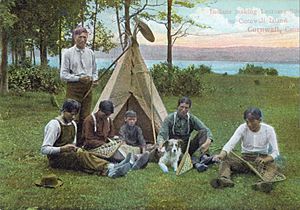Cornwall Island (Ontario) facts for kids
Cornwall Island is an island located in the Saint Lawrence River. It sits just south of the city of Cornwall in Canada. Even though the island is entirely within Canada, it is also part of the Akwesasne Mohawk territory. This territory crosses the border between Canada and the United States, and also the border between the Canadian provinces of Quebec and Ontario.
The Seaway International Bridge connects Cornwall Island to both Canada and the United States. This bridge has a crossing on each side of the island, making it easy to travel by road.
Contents
Understanding Border Issues on Cornwall Island
Cornwall Island has been the site of some disagreements, especially about how people from Akwesasne can cross the border. The Jay Treaty of 1795 gives them certain rights to cross freely.
Canadian officials have been concerned about goods being brought across the border without following all the rules. This has sometimes led to items being taken by authorities. People living in Akwesasne have also had their own disagreements, which sometimes affected the border area.
The Canada Border Services Agency Dispute
Why the Border Crossing Closed
On May 1, 2009, the Government of Canada announced a new rule. Starting June 1, officers from the Canada Border Services Agency (CBSA) would be allowed to carry firearms at all border crossings between Canada and the United States.
Leaders of the Mohawk community quickly said they did not agree with this rule. They wanted an exception for the Cornwall border crossing. They felt it was on Mohawk land, which they consider their own sovereign territory. Protests against the new rule began on the same day it was announced.
The Akwesasne Mohawk people also worried about the safety of people nearby. The border post in Cornwall is in a residential area. There is a bus stop, sports fields, a play area, and small shops nearby. They felt that armed guards would increase the risk to innocent bystanders.
On May 30, at midnight, all border guards left the Cornwall post. Hundreds of Mohawk people had gathered to protest the new policy. The guards said they left because they were worried about their safety. Canada then closed this border crossing.
The Mohawk protesters believed that allowing border guards to carry firearms went against their rights as a sovereign nation. They also thought it would make violent situations more likely. A union leader for border officers, Ron Moran, stated that the area was too dangerous for officers to return. He also mentioned that some protesters had hidden their faces, which made officers feel unsafe.
A Temporary Solution for Crossing the Border
On June 2, 2009, people from Akwesasne were allowed to cross the Seaway International Bridge again. However, the main Canadian border post remained closed. It stayed closed until July 13. On that date, a temporary border post was opened at the north end of the Seaway International Bridge.
Bob Kilger, who was the mayor of Cornwall, Ontario, was happy about the temporary border post. He hoped for a more lasting solution to the disagreement. The CBSA said that the main border crossing would only reopen if their officers could work safely. This included having all the tools they needed, like their firearms.
On June 17, the Canadian government said it would not change its decision to arm border guards. Instead, they thought about moving the border crossing on Cornwall Island closer to the city of Cornwall. This would be on the north shore of the Saint Lawrence Seaway.
On the same day, several businesses from Cornwall went to Parliament Hill. They asked the government to reopen the Cornwall Island border crossing. Closing the border had caused these businesses to lose money, as they depended on traffic crossing the border.
On September 18, the Mohawk Council of Akwesasne accused the CBSA of taking vehicles from Mohawk residents. They said these residents did not report to the new temporary border post. To get their vehicles back, people had to pay $1,000. However, Canadian laws state that all travelers entering Canada from the United States must report directly to the CBSA border crossing.
On September 19, around 12:30 PM ET, police in Cornwall were called to the Seaway International Bridge. They closed access to the bridge for five hours and sent traffic away. This closure happened because Akwesasne Mohawks were protesting the fines given to community members who did not report to the temporary border crossing.
How Things Are Now
Today, visitors from the United States who enter Cornwall Island are considered to be in Canadian territory illegally if they do not check in at the relocated Canadian border office. US border agents advise visitors to check in at the Canadian office before returning to the US side. If they don't, they could face a C$5,000 fine and have their vehicle taken away.
As of 2014, fewer people from the US visit businesses on Cornwall Island. This is because US residents must go directly to the Canadian customs office north of the river. One magazine, The Economist, explained how this change affected local businesses:
A shopping centre on Cornwall Island in the Canadian bit of Akwesasne, a piece of land set aside for the Mohawk people, shows how changing regimes harm small businesses. When the Mohawks objected to the arming of Canadian guards, Canada moved a customs post north to the mainland. Travellers from the United States now rarely stop until they reach Canadian customs. The change has cost the mall’s sports store C$50,000 a year and has made some units unrentable.


